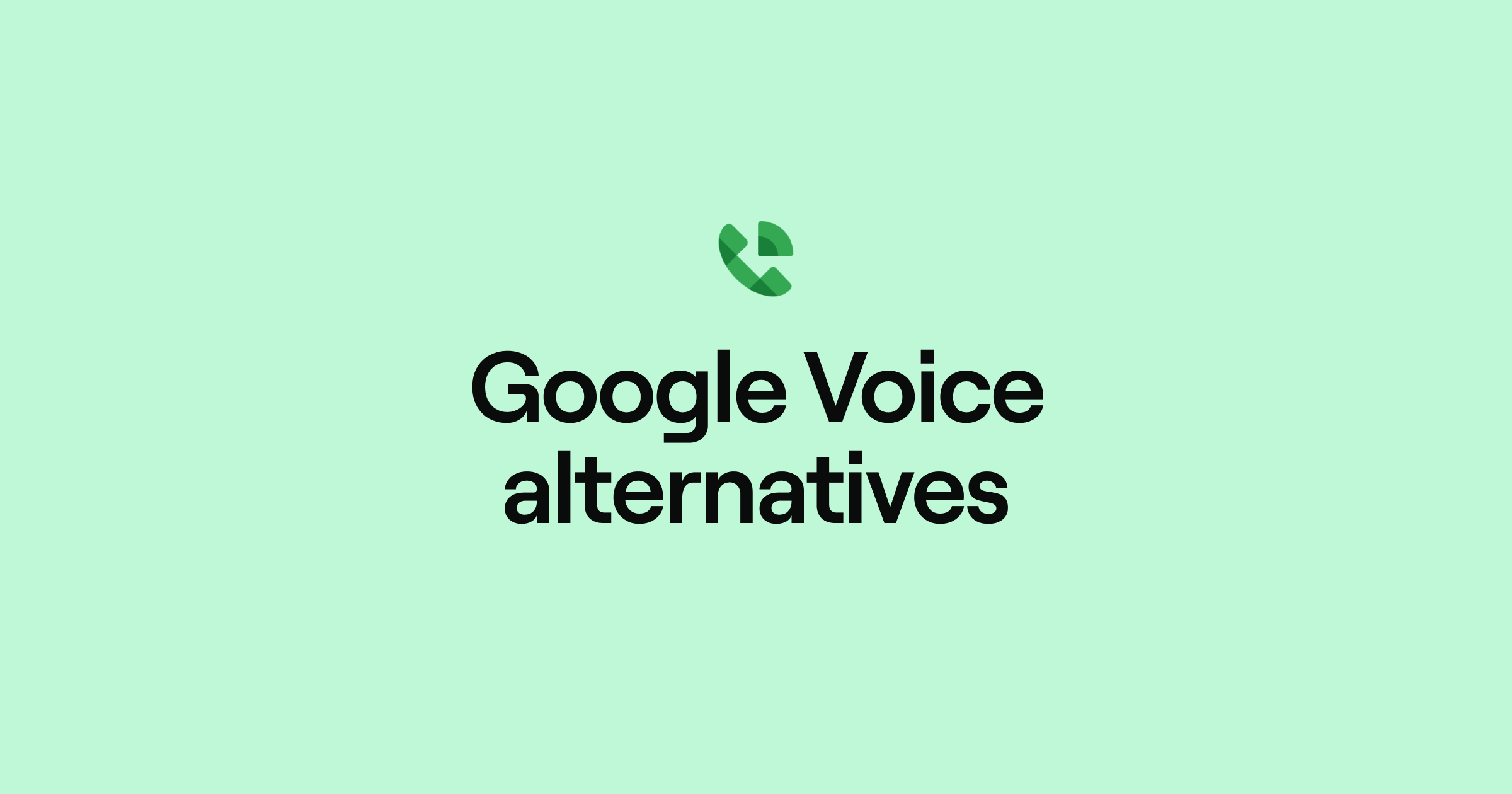Looking for an alternative to Google Voice? Maybe you’re sick of text messages living in separate inboxes and not having a toll-free business number, and you need an affordable option for both. The problem is: Google Voice doesn’t always deliver everything a modern business needs. These days, more customers are switching to affordable paid options to manage their business phone systems.
If you find yourself in need of a VoIP (Voice over Internet Protocol) service and realize Google Voice isn’t ideal for your situation, we’ve outlined eight quality alternatives to consider in 2024.
- OpenPhone: The best Google Voice alternative
- RingCentral: The best alternative for desk phone rental options
- Nextiva: The best alternative for teams that use Microsoft products
- Ooma: The best alternative for teams that need overhead paging
- Ringblaze: The best alternative with basic business phone features
- Grasshopper: The best alternative with multi-digit extensions
- Dialpad: The best alternative for contact centers
- Vonage: The best alternative with an API
We also dive into some key reasons businesses move onto Google Voice alternatives.
Google Voice alternatives offer a superior business phone experience with essential features like:
• Shared numbers
• Additional numbers
• Toll-free numbers
• Business hours
• AI features
OpenPhone is the best Google Voice alternative in 2024 because it’s affordable, packed with features, and easy to set up and use. Yes, we’re biased, but you can read the full article to see why we’re right.
What you should know about Google Voice
Pros
- Make free calls to the US
- Integrates with other Google Workspace apps
- Share responsibility for incoming calls (requires upgrade)
Cons
- Texting available in the US only
- Costs more than other business phone system providers
- No toll-free numbers
- No desktop app available
- No auto-replies
- No integrations outside Google Workspace
When you’re just launching a small business or a startup, it might make sense to use Google Voice because it’s free and your expenses are likely tight. But as your business grows, you might notice some limitations to the free and even some paid tiers of Voice, including:
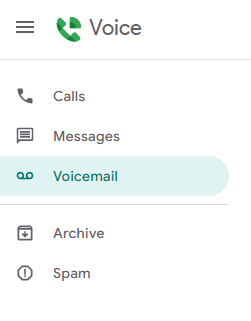
- All voicemails, calls, and text messages live in separate inboxes, which makes it difficult to catch up on conversations
- There are no integrations with any apps except tools in Google Workspace
- Texting is only available to US customers
- You can only forward texts to the email address associated with your Google Voice account
- There’s no customer support from Google
- There are no toll-free numbers or vanity numbers
- You can’t sign up outside of the US (on the free version of Google Voice)
- Without auto-reply texting, it’s harder to set expectations outside business hours
- There are no auto-attendant or IVR features
- There’s no ability to share a business phone number with your team
- Call recording for Google Workspace accounts is only available on their higher tier plans ($20 per user per month for ad-hoc recording and $30 per user per month for auto-recording of all your calls)
- Many users report poor call quality
Ideally, you need a phone system that can grow as your business grows. Plus, business owners need a business phone service to separate their personal phone numbers from work-related phone calls or text messages. Unfortunately, Google Voice can’t help with this.
Google Voice for Google Workspace pricing
Let’s say you’ve determined the free version of Google Voice won’t meet your needs. Unfortunately, you won’t have access to essential business features (call recording, phone menus, ring groups, etc.) without setting up a Google Workspace account first.
You’ll be paying a minimum $6 per user per month for Google Workspace.
After purchasing a Google Workspace account, you can add one of the following Google Voice plans.
Here’s more on how each of these Google Voice plans compare:
| Starter | Standard | Premier | |
|---|---|---|---|
| Pricing | $10 per user per month | $20 per user per month | $30 per user per month |
| Number of users | Up to 10 | Unlimited (but extra for more than 50) | Unlimited (but extra for more than 50) |
| Domestic locations | Up to 10 | Unlimited | Unlimited |
| International locations | X | X | Unlimited |
| Auto attendants | X | ✓ | ✓ |
| Call recordings | X | On-demand | Automatic |
| Desk-phone compatibility | X | ✓ | ✓ |
| eDiscovery | X | ✓ | ✓ |
| Ring groups | X | ✓ | ✓ |
| BigQuery exports | X | X | ✓ |
Each plan includes free calls to the US from anywhere, VoIP call forwarding, voicemail transcription, and other basic calling features.
But as mentioned earlier, key features are missing — texting is only available to US customers. And if you need a toll-free or vanity number, shared numbers, or integrations with non-Google apps, Google Voice can’t help.
These are just some of the many reasons businesses choose Google Voice alternatives.
Comparing top Google Voice alternatives
Here’s a quick breakdown of the top Google Voice alternatives:
| Provider | Price | Unlimited calling to US & Canada | SMS/MMS to US & Canada | Shared phone numbers | Additional phone numbers |
|---|---|---|---|---|---|
| Google Voice | Starts at $16 per user per month(must have Google Workspace) | Unlimited calls to Canada from the US only | US customers only | Requires upgrade (ring groups only) | X |
| OpenPhone | Starts at $15 per user per month | ✓ | ✓ | ✓ | $5 per number per month |
| RingCentral | Starts at $20 per user per month | ✓ | 25 texts per user per month | ✓ | $4.99 per number per month |
| Nextiva | Starts at $23.95 per user per month | ✓ | Requires upgrade | ✓ | Requires the purchase of an additional user seat |
| Ooma | Starts at $19.95 per user per month | ✓ | Requires upgrade | ✓ | $9.95 per number per month |
| Ringblaze | Starts at $15 per user per month | ✓ | ✓ | X | $4-5 per month |
| Grasshopper | Starts at $15 per month | ✓ | Local numbers only | X | $9 per number per month |
| Dialpad | Starts at $15 per user per month | ✓ | US & Canadian customers only | ✓ | Requires upgrade |
| Vonage | Starts at $19.99 per user per month (1-year contract) | ✓ | Local US and Canadian numbers only | Requires upgrade or $4.99 add-on for each call group | $14.99 per number per month |
Keep reading to get a detailed summary of each one.
Breaking down the best Google Voice alternatives
While there are some advantages to using Google Voice for your business, there are better business phone solutions that:
- Save time
- Integrate with tools you already use
- Let your team collaborate more effectively on any phone communication
Google Voice isn’t a sustainable phone option — especially if your business is growing. It lacks features around call handling, call forwarding and routing, virtual number sharing, and more.
These eight VoIP solutions can serve as a replacement for Google Voice and provide the business phone features your team needs.
1. OpenPhone: The best Google Voice alternative
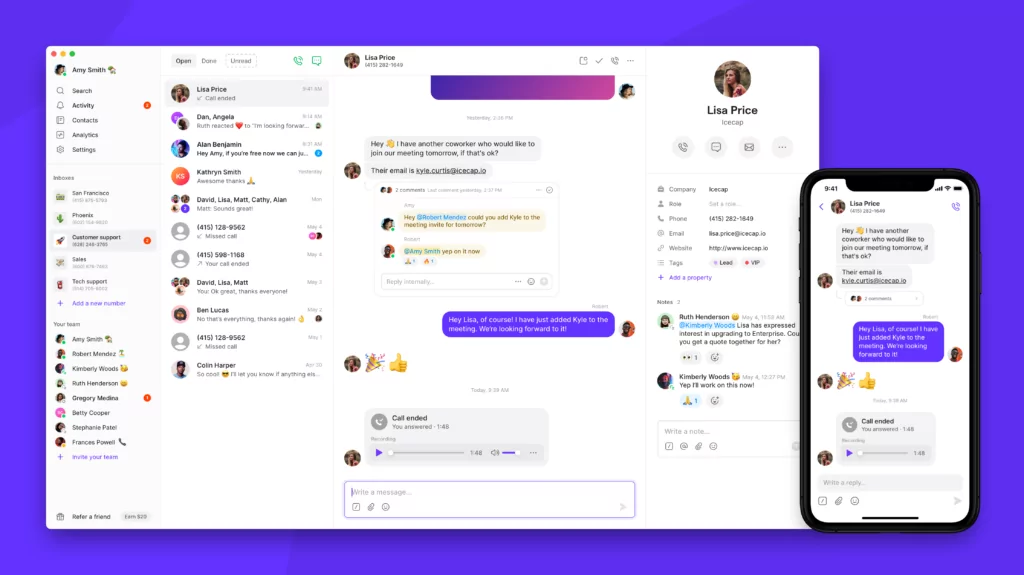
OpenPhone vs Google Voice
| Feature | OpenPhone | Google Voice |
|---|---|---|
| Pricing | Starts at $15 per month per user | $16 per user per month (including Workspace subscription) |
| Unlimited calling to US & Canada | ✓ | ✓ |
| SMS, MMS messaging | ✓ | US customers only |
| Voicemail transcriptions | ✓ | ✓ |
| Business hour settings | ✓ | ✓ |
| Additional phone numbers | $5 per number | Varies |
| Number porting | ✓ | ✓ |
| Call recording | ✓ | Requires upgrade |
| Shared phone numbers | ✓ | Ring groups only; requires upgrade |
| IVR (phone menu) with extensions | Requires upgrade | Requires upgrade |
| Auto-replies | ✓ | X |
| Snippets | ✓ | X |
| Slack integration | ✓ | X |
| Zapier integration | ✓ | X |
| CRM integration | ✓ | X |
| iOS and Android apps | ✓ | ✓ |
| Browser app | ✓ | ✓ |
| Desktop app | ✓ | X |
For small businesses and startups, OpenPhone is a highly-rated Google Voice alternative with thousands of happy users. And it’s even one of the most cost-effective options on this list!
OpenPhone is a phone solution your sales, operations, and customer support teams — among others — can easily use to manage inbound calls and SMS messages together.
With OpenPhone, multiple team members can access a shared business phone number and collaborate on conversations through comments. When teammates use different numbers, calls can be routed to the right person with just a few taps.
If you want to create a dedicated customer service line or a number for specific departments, OpenPhone gives you the capability Google Voice lacks. And when a customer calls, the platform even functions as a lightweight CRM (though you also can connect with HubSpot or Salesforce for even better information about your customers).OpenPhone also supports Canadian calling and offers local Canadian phone numbers in addition to US local numbers and toll-free numbers. This allows you to easily operate in or expand your business to Canada.
💡 Learn more about how OpenPhone vs Google Voice compare.
OpenPhone pricing plans
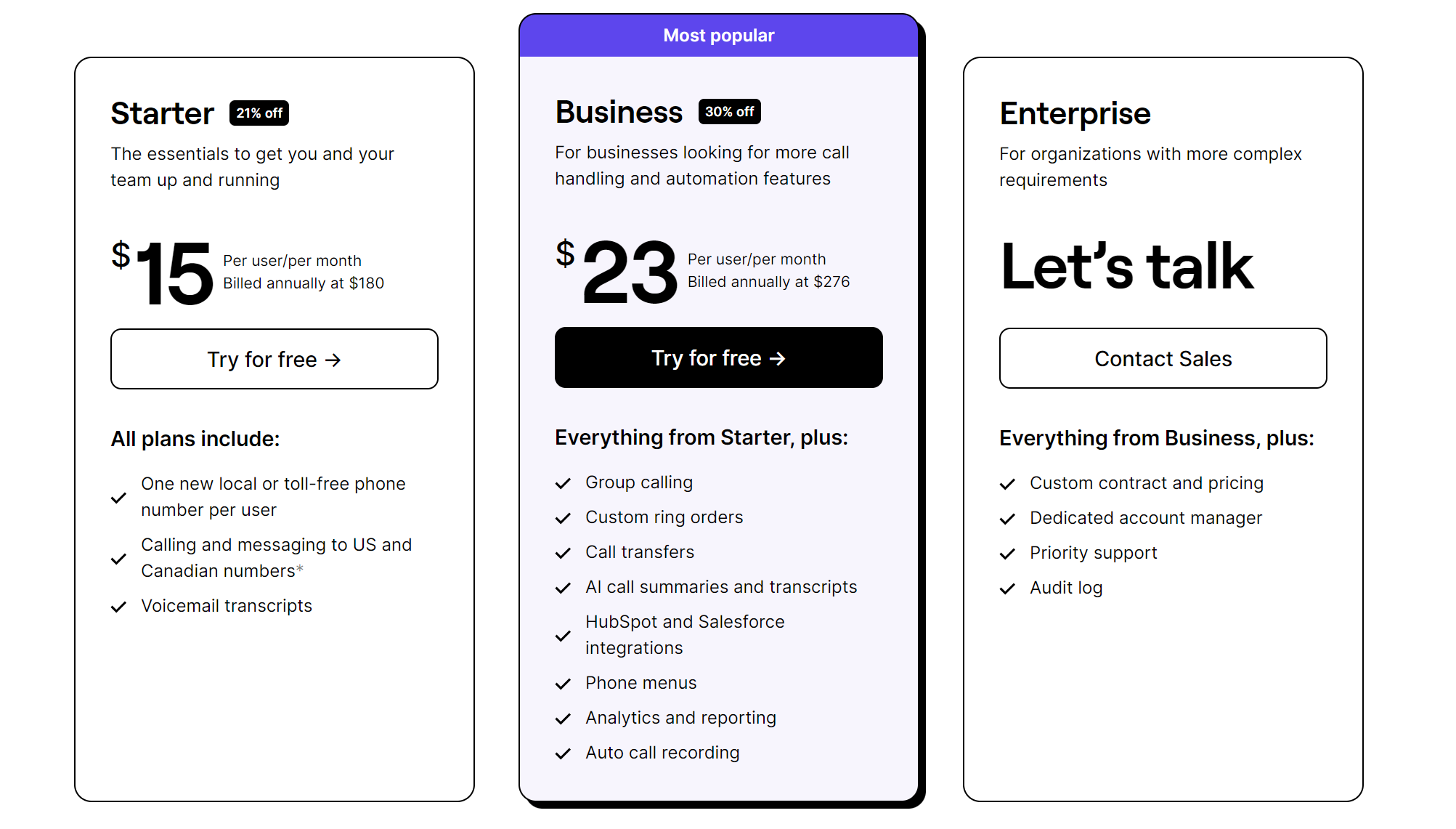
OpenPhone offers transparent pricing and some of the best rates in the industry for must-have business phone features.
- Starter: $15 per user per month for shared phone numbers, voicemail transcriptions, free calls and texts in the US and Canada, and dozens of ways to streamline your business’s phone communication
- Business: $23 per user per month for auto-attendant (IVR), call transferring, CRM integrations, analytics, and more advanced features
- Enterprise: Custom-fit solutions with custom-fit pricing
Try out OpenPhone for yourself by signing up for a free, seven-day trial.
What customers are saying about OpenPhone
“I have been a user of OpenPhone for the past three years, and I have always been impressed with its affordability and functionality. Their pricing plans are incredibly reasonable and provide excellent value for their services. What sets OpenPhone apart is its modern app user interface – it is intuitive, user-friendly, and seamlessly integrates with my daily operations. The unlimited calls and SMS within the US and Canada make it an unbeatable choice for businesses like mine operating within these regions.” — Review from G2
“The technicians only text and call on the OpenPhone line. This is huge. Both myself and my co-worker work in this department. We are able to copy and paste from our SRM straight from the computer, and the techs receive it on their tablets as a text message. We don’t need to explain who we are or see different text line messages come through our phones — it is just one. No confusion, super clean, and the history stays and is great to look back on. It’s an easy, single line for service calls with two people using it. We love it and are so excited we implemented this. Thank you for a great product.” — Review from G2
G2 ratings indicate that OpenPhone ranks better than Google Voice for ease of use, setup, quality of support, and more:
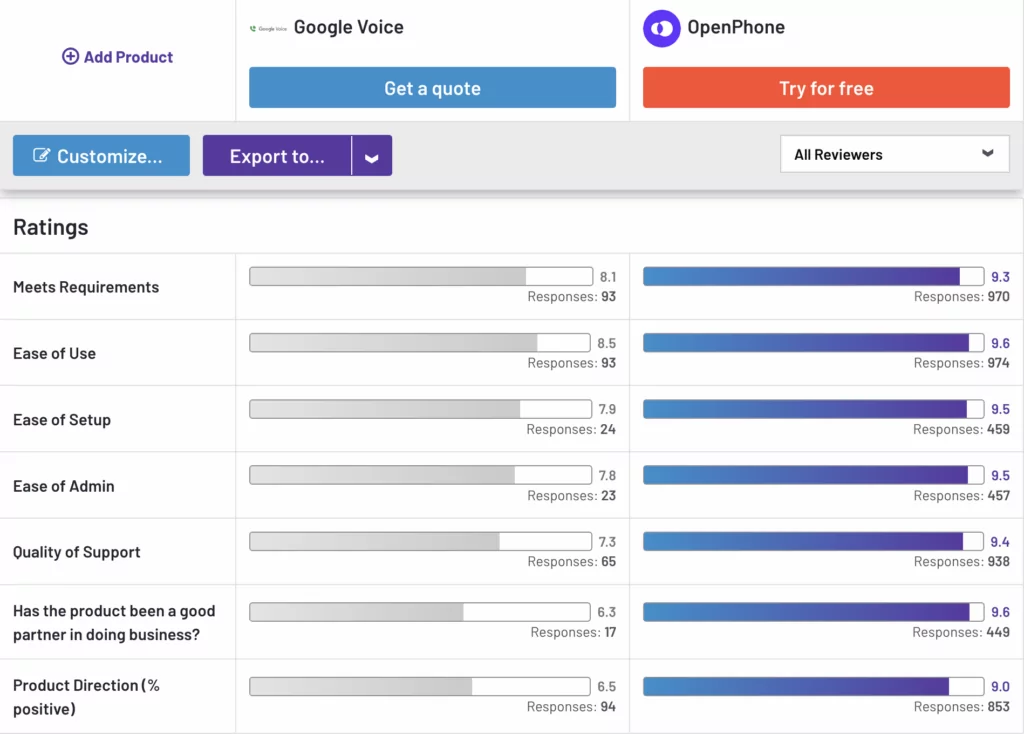
1. Go to www.google.com/voice/unlock.
2. Find the Google Voice number you want to port.
3. Under this number, click “Unlock my number.” Note: if you want to select multiple numbers to port, select them in the dropdown menu.
4. A pop-up will prompt you to pay a $3 porting fee to move your number to a new provider.
5. Pay this fee via Google Pay.
6. The status on your number should now read “unlocked.”
If you’re working from a Google Workspace, we’ve provided an additional guide for porting numbers to help.
2. RingCentral: The best alternative for desk phone rental options
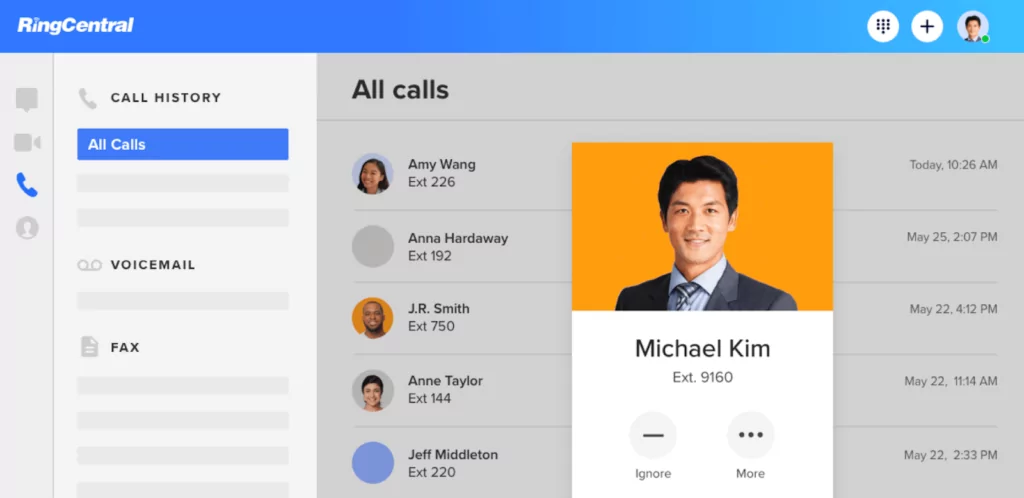
Google Voice vs RingCentral
| Feature | Google Voice | RingCentral |
|---|---|---|
| Pricing | $16 per user per month (including Workspace subscription) | Starts at $20 per month per user |
| Unlimited calling to US & Canada | ✓ | ✓ |
| SMS, MMS messaging | US customers only | ✓ |
| Voicemail transcriptions | ✓ | ✓ |
| Business hour settings | ✓ | ✓ |
| Additional phone numbers | Varies | $4.99 per month per number |
| Call recording | Requires upgrade | On-demand recordings only without upgrade |
| Shared phone numbers | Ring groups only; requires upgrade | Up to 20 users |
| IVR (phone menu) with extensions | Requires upgrade | ✓ |
| Auto-replies | X | X |
| Snippets | X | X |
| Slack integration | X | ✓ |
| Zapier integration | X | Requires upgrade |
| CRM integration | X | Requires upgrade |
| iOS and Android apps | ✓ | ✓ |
| Browser app | ✓ | ✓ |
| Desktop app | X | ✓ |
RingCentral is one of the older business phone solutions for unified communications. It’s also accessible online and with compatible desk phones (if your company still uses them).
This platform has dozens of features, from basic call management and SMS options to a contact center add-on for your customer support team. However, getting what you need without paying for other bells and whistles can be difficult with RingCentral.
All RingCentral plans include essential features like toll-free numbers, unlimited calls within the US and Canada, SMS, voicemail-to-text, team messaging, and document sharing. But you should read the fine print carefully to avoid hidden fees. Their base plan, for example, only lets you send 25 text messages per user per month to anyone in the US or Canada. Anything more than that and you’re paying extra.
RingCentral also has limitations around storing conversations (unless you pay for their most expensive plan). For example:
- Call recordings are deleted after 90 days
- Only 200 on-demand call recordings can be stored per user
- Users are limited to storing up to 5,000 messages
Even if you do upgrade to Ultra, you’ll still be limited by RingCentral’s time-based data retention policies.
If you’re a small business or a startup, prepare yourself for sticker shock.
RingCentral pricing plans

RingCentral updated its pricing in 2023. Their previous four tiers were simplified into three — each with cutbacks from their earlier counterparts.
- Core: $20 per user per month for unlimited domestic calling and 25 texts per user per month
- Advanced: $25 per user per month includes auto call recording, app integrations like Salesforce and Zendesk, and 100 texts per user per month
- Ultra: $35 per user per month includes unlimited file sharing for recordings, HD video whiteboards and messaging, and 200 texts per user per month
What customers are saying about RingCentral
“Clunky and outdated user interface. Lack of support both while as a customer and when trying to transition to a better provider. They refuse to help port our numbers.” – Review from G2
“The support is little to none when something goes wrong. Salespeople give you much attention but account managers pay you no attention once signed up.” – Review from Capterra
“I wouldn’t say I like the Ring Central’s price. The price is enormous when used in a smaller company, and it is not much change in a large company. There should be some discounts for more licenses.” – Review from G2
3. Nextiva: The best alternative for teams that use Microsoft products
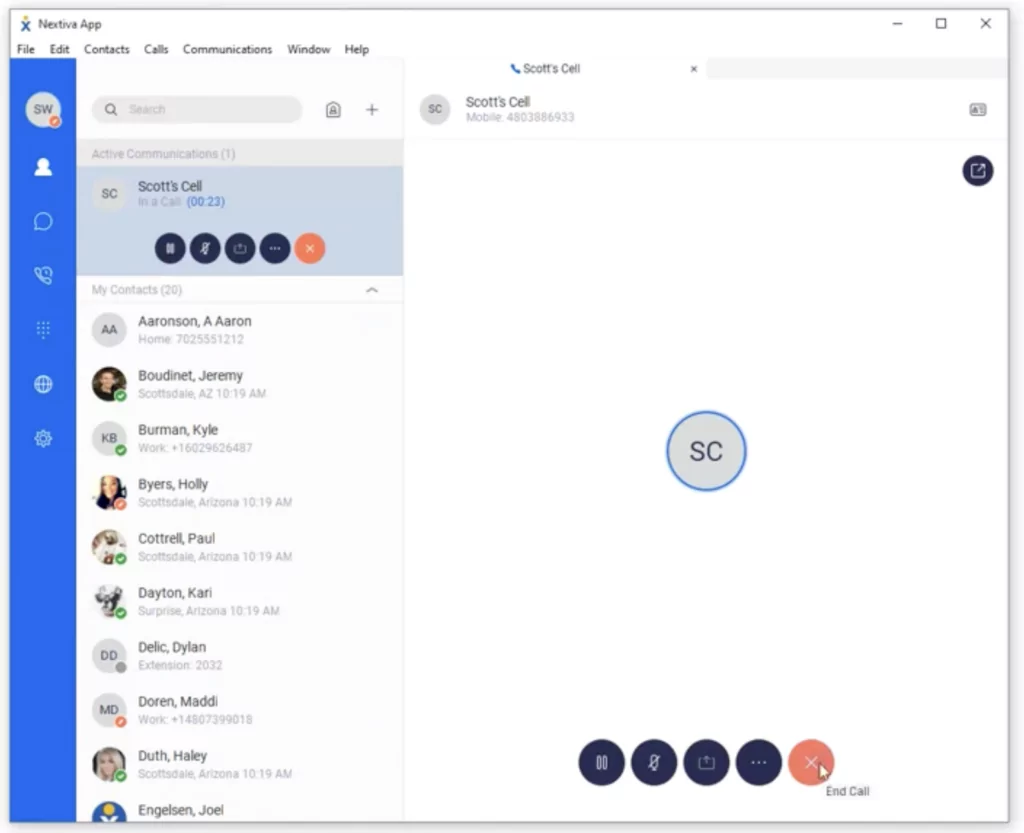
Google Voice vs Nextiva
| Feature | Google Voice | Nextiva |
|---|---|---|
| Pricing | $16 per user per month (including Workspace subscription) | Starts at $23.95 per user per month |
| Unlimited calling to US & Canada | ✓ | ✓ |
| SMS, MMS messaging | US customers only | Requires upgrade |
| Voicemail transcriptions | ✓ | Requires upgrade |
| Business hour settings | ✓ | ✓ |
| Additional phone numbers | Varies | X |
| Call recording | Requires upgrade | Requires upgrade |
| Shared phone numbers | Ring groups only; requires upgrade | ✓ |
| IVR (phone menu) with extensions | Requires upgrade | ✓ |
| Auto-replies | X | X |
| Snippets | X | X |
| Slack integration | X | X |
| Zapier integration | X | ✓ |
| CRM integration | X | Requires upgrade |
| iOS and Android apps | ✓ | ✓ |
| Browser app | ✓ | X |
| Desktop app | X | ✓ |
Nextiva is a VoIP phone service that supports calls in the US and Canada. It’s a good fit for businesses that run on Oracle Sales Cloud or Microsoft Dynamics since Nextiva offers integrations with both.
Though it does offer business communication features that Google Voice doesn’t (such as auto-attendant and customer support), Nextiva’s lack of other features can be problematic for small businesses and startups.
First, its SMS features are limited at best — Nextiva doesn’t offer auto-replies, scheduled messages, or templates. And while it works okay for standard office landlines, limitations with call recordings and voicemail transcriptions mean you can’t use it as a tool for coaching your team or improving customer service without paying far more.
Nextiva pricing plans

The amount you pay per user to use Nextiva varies depending on the size of your business. Smaller teams pay more for each of their teammates, while larger teams pay less.
Here’s how their plans break down for teams of 1-4 users:
- Essential: $23.95 per user per month for auto-attendant and unlimited voice and video calls
- Professional: $27.95 per user per month for CRM integrations and SMS/MMS texting
- Enterprise: $37.95 per user per month for call recording and call analytics
What customers are saying about Nextiva
“Their pricing and contracts all but force you to stick with them long term or pay an arm and a leg to leave.” – Review from Capterra
“Unreliable phone service (calls not going through), and poor customer service when reporting issues.” – Review from G2
“Auto attendant was not set up as planned. Text messages were not working. CRM not working. I spent days asking to fix things but each time more problems and more things did not work. We were running in circles with the problems. The waiting time for support was up to 50 minutes. They usually were not able to fix the issue but forwarded the case to the next level. I talked to the manager and he forwarded me to the technician. The technician forwarded my case again. I wrote an email to the manager but I did get a reply.” – Review from G2
4. Ooma: The best alternative for teams that need overhead paging
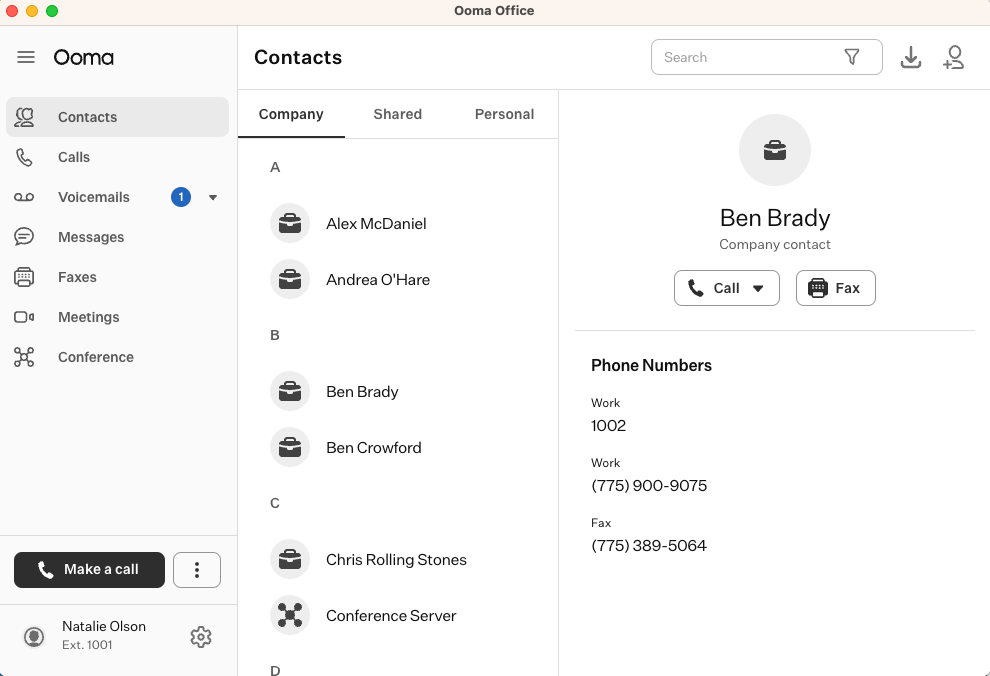
Google Voice vs Ooma
| Feature | Google Voice | Ooma |
|---|---|---|
| Pricing | $16 per user per month (including Workspace subscription) | $19.95 per user per month |
| Unlimited calling to US & Canada | ✓ | ✓ |
| SMS, MMS messaging | US customers only | Requires upgrade |
| Voicemail transcriptions | ✓ | Requires upgrade |
| Business hour settings | ✓ | ✓ |
| Additional phone numbers | Varies | $9.95 per number per month |
| Call recording | Requires upgrade | Requires upgrade |
| Shared phone numbers | Ring groups only; requires upgrade | ✓ |
| IVR (phone menu) with extensions | Requires upgrade | ✓ |
| Auto-replies | X | X |
| Snippets | X | X |
| Slack integration | X | X |
| Zapier integration | X | X |
| CRM integration | X | Requires upgrade |
| iOS and Android apps | ✓ | ✓ |
| Browser app | ✓ | X |
| Desktop app | X | Requires upgrade |
Ooma is a Google Voice alternative with virtual receptionists, overhead paging support, and unlimited voice calls to the US, Canada, Puerto Rico, and Mexico. You can access their mobile app and desk phone service directly from the base plan.
Although it’s a Google Voice alternative with a video conference feature, Ooma lacks advanced features (unless you can afford to upgrade). It only offers phone numbers local to the US, for one. You also need to upgrade for features like texting, voicemail transcriptions, and access to the Ooma desktop app.
Unless you’re already using desk phones and think overhead paging would be useful to your business, Ooma probably won’t make much sense for your business communication stack.
Ooma pricing plans

Ooma offers three different pricing plans.
- Essentials: $19.95 per user per month for auto-attendants, call forwarding, and SMS messages
- Pro: $24.95 per user per month for call recording, voicemail transcriptions, video conferencing, analytics, and access to Ooma’s desktop app
- Pro Plus: $29.95 per user per month for call queuing, CRM integrations, hot desking, and advanced call flows
What customers are saying about Ooma
“When it works, it does the job. But when it doesn’t, there is a major disruption to business and the perception of our clients is hurt. Wouldn’t really recommend this product unless you have a full-time IT person to manage it.” – Review from Capterra
“The calls would always drop or the person on the other end wouldn’t be able to hear us. … The connectivity was a big issue.” – Review from Capterra
5. Ringblaze: The best alternative with basic business phone features
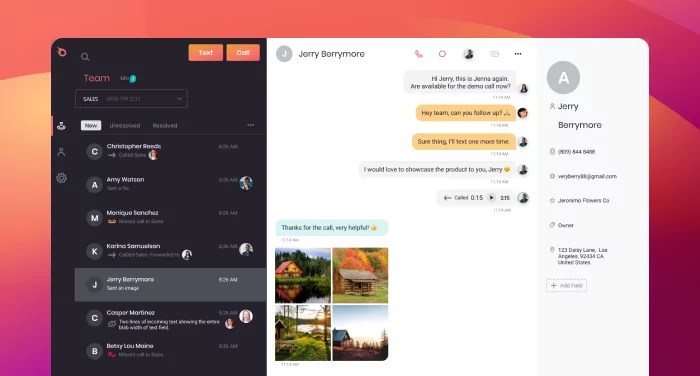
Google Voice vs Ringblaze
| Feature | Google Voice | Ringblaze |
|---|---|---|
| Pricing | $16 per user per month (including Workspace subscription) | $15 per user per month |
| Unlimited calling to US & Canada | ✓ | ✓ |
| SMS, MMS messaging | US customers only | ✓ |
| Voicemail transcriptions | ✓ | X |
| Business hour settings | ✓ | X |
| Additional phone numbers | Varies | Varies |
| Call recording | Requires upgrade | ✓ |
| Shared phone numbers | Ring groups only; requires upgrade | ✓ |
| IVR (phone menu) with extensions | Requires upgrade | ✓ |
| Auto-replies | X | X |
| Snippets | X | X |
| Slack integration | X | X |
| Zapier integration | X | X |
| CRM integration | X | Requires upgrade |
| iOS and Android apps | ✓ | ✓ |
| Browser app | ✓ | ✓ |
| Desktop app | X | ✓ |
Ringblaze is all about call collaboration. A shared dashboard, call recording, call assignments, and a click-to-call website widget for customers add to the collaboration experience it offers.
But if you want to save time on repetitive tasks or log your phone communication elsewhere, you won’t be able to — Ringblaze suffers from a lack of integrations.
There are a few other limitations to keep in mind:
- Stored call history only for 90 days
- No advanced features (including AI)
- Inconsistent monthly fees
Ringblaze pricing plans
Ringblaze only offers one plan, which costs $15 per user per month. You can share phone numbers, record calls, and get unlimited minutes to the US and Canada.
Keep in mind you may run into inconsistent monthly fees — calls on toll-free numbers and internal calls (between team members) require per-minute payments.
What customers are saying about Ringblaze
“I was thinking of switching away from a VoIP provider I have now but will not be doing so due to the dropped calls.” – Review from Capterra
6. Grasshopper: The best alternative with multi-digit extensions
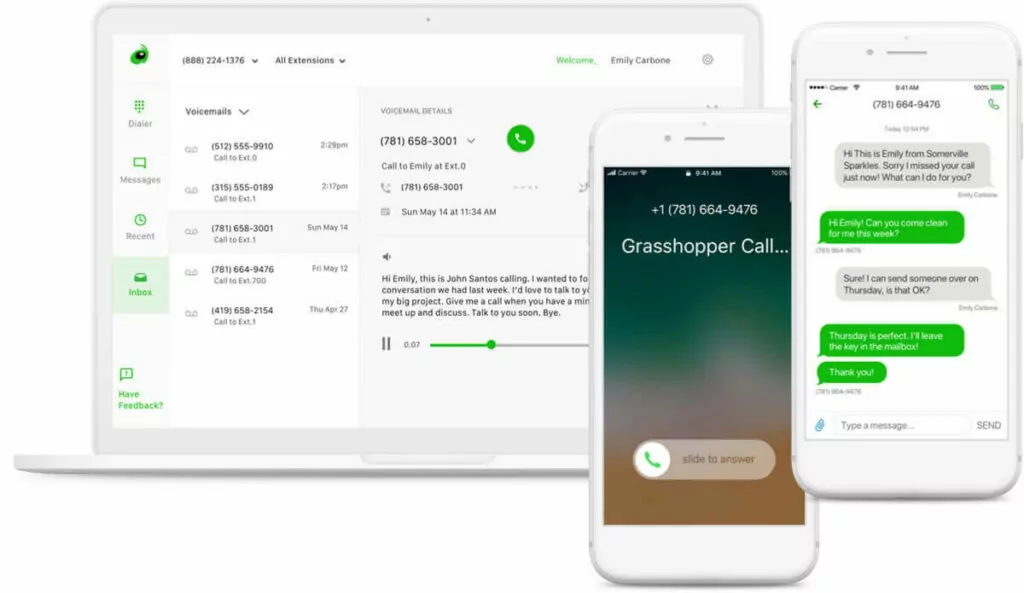
Google Voice vs Grasshopper
| Feature | Google Voice | Grasshopper |
|---|---|---|
| Pricing | $16 per user per month (including Workspace subscription) | $15 per user per month |
| Unlimited calling to US & Canada | ✓ | ✓ |
| SMS, MMS messaging | US customers only | Local numbers only |
| Voicemail transcriptions | ✓ | ✓ |
| Business hour settings | ✓ | ✓ |
| Additional phone numbers | Varies | $10 per number per month |
| Call recording | Requires upgrade | X |
| Shared phone numbers | Ring groups only; requires upgrade | X |
| IVR (phone menu) with extensions | Requires upgrade | ✓ |
| Auto-replies | X | First-time callers only |
| Snippets | X | X |
| Slack integration | X | X |
| Zapier integration | X | X |
| CRM integration | X | X |
| iOS and Android apps | ✓ | ✓ |
| Browser app | ✓ | X |
| Desktop app | X | ✓ |
Grasshopper is a popular VoIP service offering an easy-to-use interface and local and toll-free numbers. You can also put unlimited users on each plan, which makes it more cost-effective than Google Voice.
But while Grasshopper may be well-known and have enough business features to replace Google Voice, it’s not built for collaboration. There are no integrations, shared phone numbers, or call recording capabilities. Plus, pricing can be confusing, too.
Grasshopper pricing plans

Grasshopper requires business owners to invest in 100% of its features — voicemail transcriptions, call reports, and more — no matter which plan you choose. Their three tiers simply include a different number of phone numbers and extensions. Adding more numbers will cost you extra ($10 per number per month, to be precise).
- True Solo: $15 per month for one user, one phone number, and one extension
- Solo Plus: $25 per month for one number and three extensions
- Small Business: $55 per month for four numbers and unlimited extensions
What customers are saying about Grasshopper
“Over the few years I used it, they never made any upgrades. The iOS app functioned well enough for basic things, but seemed to be forever just a beta product. The website’s settings were hard to navigate, and setting up the incoming call workflow was too cumbersome.” – Review from Capterra
“The problem with this software is that it is full of glitches. There were several times when Grasshopper sent the voice messages to the wrong phone numbers, the extensions got changed or were wrong, or the app just stopped working all together. It seemed like every week or two, we had to waste time calling in to customer service to get them to fix the problems. Also, you could not send mass texts or multiple texts to more than one person without them seeing each other’s phone numbers and all responses going to all people in the group text.” – Review from Capterra
“The connection is really weak. Whenever I follow instructions to access a feature, it still doesn’t work. Calling in for help takes hours to resolve or isn’t resolved at all.” – Review from Capterra
7. Dialpad: The best alternative for contact centers
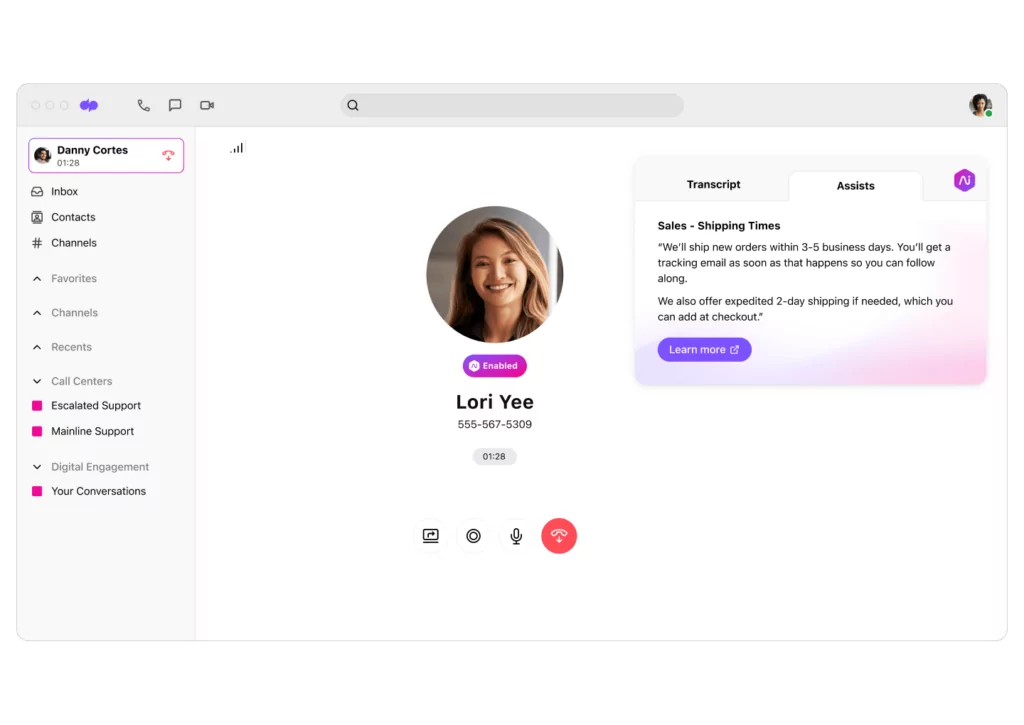
Google Voice vs Dialpad
| Feature | Google Voice | Dialpad |
|---|---|---|
| Pricing | $16 per user per month (including Workspace subscription) | $15 per user per month |
| Unlimited calling to US & Canada | Unlimited calls to Canada from US only | ✓ |
| SMS, MMS messaging | US customers only | US & Canadian customers only |
| Voicemail transcriptions | ✓ | ✓ |
| Business hour settings | ✓ | ✓ |
| Additional phone numbers | Varies | Requires upgrade |
| Call recording | Requires upgrade | ✓ |
| Shared phone numbers | Ring groups only; requires upgrade | ✓ |
| IVR (phone menu) with extensions | Requires upgrade | ✓ |
| Auto-replies | X | Requires upgrade |
| Snippets | X | X |
| Slack integration | X | Requires upgrade |
| Zapier integration | X | Requires upgrade |
| CRM integration | X | Requires upgrade |
| iOS and Android apps | ✓ | ✓ |
| Browser app | ✓ | ✓ |
| Desktop app | X | ✓ |
Dialpad is a cloud communications platform primarily geared toward call centers. They tout their use of technology to provide live speech coaching and AI-powered call and voicemail transcriptions.
But like other alternatives, Dialpad’s standard plan lacks some essential business phone features. To access additional phone numbers and separate your teams (like customer support and sales), you’ll have to upgrade to a Pro plan. The same is true if you require integrations beyond Microsoft 365 or Google Workspace (or want to text internationally).
Dialpad pricing plans

There are three pricing tiers with Dialpad, each providing one local number with unlimited US and Canada calling, SMS and MMS, and video meetings.
Here are the options based on monthly billing:
- Standard: $15 per user per month for AI-powered call and voicemail transcriptions, Google Workspace, and Microsoft 365 integrations
- Pro: $25 per user per month for the option to have additional numbers, international texting, auto-replies, and CRM integrations (minimum of three users)
- Enterprise: Call for a quote and get 100% uptime, unlimited locations and ring groups, SSO integrations, and live agent support
What customers are saying about Dialpad
“The fact that when you get phone calls through Dialpad to your cell phone you can’t tell if it is a personal call or a call to your work number. If Dialpad was able to give a notification that it is a “Dialpad” call it would make answering the calls easier. I have answered personal calls with my work phone intro. So that is my biggest and honestly only real complaint with Dialpad.” – Review from G2
“The support ended after the contract was signed. Company needs to bridge sales and support to continue to grow with mid-enterprise clients. Hard time reaching my guy after we signed, prior to that we talked a few times a day. That said, I reached customer service for a request and they solved my issue immediately.” – Review from Capterra
8. Vonage: The best alternative with an API
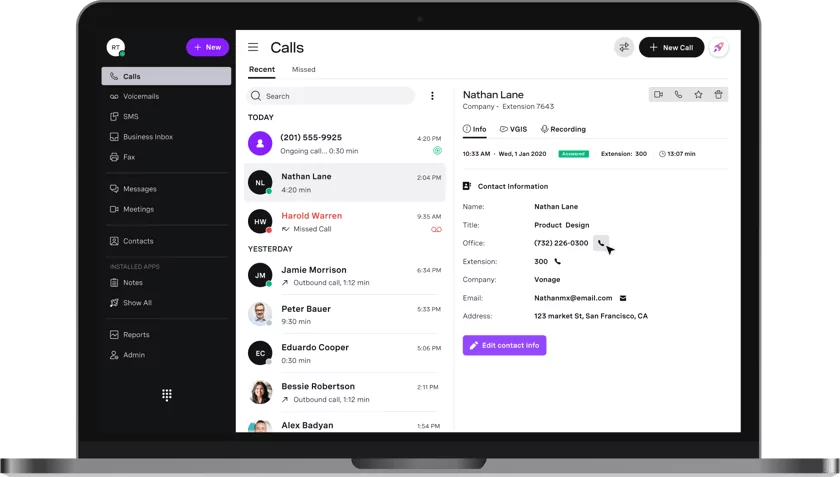
Google Voice vs Vonage
| Feature | Google Voice | Vonage |
|---|---|---|
| Pricing | $16 per user per month (including Workspace subscription) | $19.99 per user per month |
| Unlimited calling to US & Canada | Unlimited calls to Canada from US only | ✓ |
| SMS, MMS messaging | US customers only | US & Canadian numbers only |
| Voicemail transcriptions | ✓ | Requires upgrade |
| Business hour settings | ✓ | ✓ |
| Additional phone numbers | Varies | $14.99 per number per month |
| Call recording | Requires upgrade | Requires upgrade; 15 hours max |
| Shared phone numbers | Ring groups only; requires upgrade | Requires upgrade or $4.99 add-on for each call group |
| IVR (phone menu) with extensions | Requires upgrade | Requires upgrade |
| Auto-replies | X | X |
| Snippets | X | X |
| Slack integration | X | ✓ |
| Zapier integration | X | Requires upgrade |
| CRM integration | X | Requires upgrade |
| iOS and Android apps | ✓ | ✓ |
| Browser app | ✓ | ✓ |
| Desktop app | X | ✓ |
Vonage was one of the early pioneers of residential telecommunications over VoIP. With over 50 features across all plans (including toll-free numbers and an API), it’s a viable alternative to Google Voice.
It may have some features you can’t get with Google Voice, including integrations outside of Google Workspace. However, Vonage isn’t a low-cost alternative — if you want to access the features modern businesses expect, it’s going to cost you.
Vonage pricing plans
Vonage has three pricing plans to choose from. Unfortunately, small businesses (1-4 users) will pay a premium. Discounts are offered, starting with the 5th user.
- Basic: $19.99 per line, per month; free calls and texts in the US, 20+ integrations
- Premium: $29.99 per line, per month; unlimited meetings, multi-level auto attendant, CRM integration
- Advanced: $39.99 per line, per month; on-demand call recording (15 hours), call group, visual voicemail
But here’s where Vonage gets you. They consider many features add-ons, so be sure to factor that into your monthly per-line plan fee. Here are some examples:
- Voicemail transcription: $4.99 per month
- Toll-free numbers: $39.99 per number per month
- Vonage for Salesforce: $4.99 per month
- Call queue: $14.99 per month
- Call recording: $4.99 per month
What customers are saying about Vonage
“Porting my old number from Verizon was horrible, Verizon was good on their end, Vonage dropped the ball multiple times, took many calls and chat to resolve. Billing errors took 4 months to resolve. Totally unable to speak to anyone by phone with a company that “specializes” in phone communications.” – Review from G2
“The biggest con was the price — it kept growing and growing to a point where we had to switch over to a new provider. They were also missing a lot of integration with third-party applications.” – Review from Capterra
How to select the right Google Voice alternative for your team
Not sure how to choose the right Google Voice alternative? Here’s what you should look for:
- Features: Modern businesses need modern features to build better relationships with customers. This means that VoIPs offering little more than calling and voicemail aren’t enough to make the cut. Keep an eye out for alternatives that offer automated texting features like auto-replies, snippets, and AI-generated message responses, as those tend to be overlooked by plenty of business phone providers.
- Budget: If you’re an early-stage entrepreneur or a leader of a growing business, you’re probably working with a leaner budget. The best providers are cost effective and don’t require you to upgrade to a higher-tier plan based on the number of users you have. For example, RingCentral only lets you have up to 20 users on their base plan.
- Integrations: The average tech stack for a small business has 172 apps, so you need to invest in integrations to avoid siloing your conversation data. The best Google Voice alternatives offer multiple ways to connect with the tools you’re already using (like Slack). They can also integrate with platforms like Zapier so you can build custom workflows between different apps and automate repetitive tasks.
- Reliability: You can’t afford for your business phone to go down — and neither can your customers. Prioritize business phone providers that have a history of reliable uptime.
- Ease of use: Making the switch to a new VoIP can be stressful or off-putting for your team. Choose a Google Voice alternative that offers apps on every device so team members can use what’s most convenient for them.
- Setup: Some Google Voice alternatives take hours to set up and sometimes days to customize to your liking. Unless you want to put your business conversations on hold, choose your alternative wisely.
- Support: The customer service of your VoIP solution can make or break the efficiency of your business phone. Providers with a history of below-average support should be crossed off your list (or at least subject to scrutiny).
OpenPhone: The best Google Voice alternative
If you’re looking for a Google Voice alternative, look no further than OpenPhone.
OpenPhone is a business phone built specifically for startups and scaling businesses. Unlike Google Voice and most of its competitors, OpenPhone offers all of the key features a business phone needs — with no hidden fees and starting at just $15 per user per month. OpenPhone also has a sleek user interface and dedicated customer support to make your experience 10 times better.
Ready to make the switch? You can start calling and texting with OpenPhone today.
Sign up for a free trial in under a minute.
FAQ
We’re admittedly partial here — but if you’re looking for a Google Voice alternative, OpenPhone should be your first choice.
We make it easier to build stronger relationships with your customers. You can use auto-replies, scheduled text messages, and our integrations to automate specific touchpoints. Plus, connect OpenPhone to your tech stack. You can even work together and share responsibility for calls using a shared number.
One of the biggest limitations of Google Voice’s free version is the lack of customer support from Google. If you have any questions or problems with the service, you’re on your own.
Additionally, some features are unavailable with Google Voice (free or paid), such as toll-free numbers or vanity numbers, shared numbers to support collaboration, auto-replies, and a desktop app. Google Voice also only integrates with other Google apps.And call quality can be poor at times.
Yes! And it only takes a few minutes to port your number from Google Voice to OpenPhone. Keep in mind if you are using the free version of Google Voice, Google does charge a one-time $3 fee to transfer your number anywhere else.
Like most VoIP services, Google Voice works via an internet connection (Wi-Fi or data plan) to make phone calls and send text messages. No desk phones or landlines are required. As long as you have an internet connection and an internet-enabled device (cellphone, laptop, computer, or another mobile device), you can use Google Voice.
Google Voice allows you to make free calls just by signing up with a Gmail address. It can be used for both personal and professional reasons — though it is built specifically for personal communications. Having more than one Google Voice number also isn’t possible with their free plan.
There aren’t any free alternative apps like Google Voice — at least, none to provide all the features businesses need. Call forwarding, toll-free numbers, and call recording…these are all essential features for any business looking to give itself a competitive edge. However, OpenPhone offers a free seven-day trial to test out the platform, after which plans begin at $15 per user per month.
If you’re a small business, startup, or solopreneur, OpenPhone is the ideal Google Voice alternative for you. It’s affordable enough for anyone just starting out and capable of upgrading with add-ons like Salesforce and HubSpot integrations when you want an entire company up and running on your phone system. OpenPhone also includes internal team collaboration to solve problems more quickly and build better relationships with your customers.
OpenPhone supports Canadian calling and local or toll-free Canadian phone numbers. If you need a Canadian-friendly number to do business in Canada, OpenPhone is your best bet for a Google Voice alternative. OpenPhone also offers a wide range of local US numbers if your company wants to have a local presence in both countries.
For personal use, Google Voice is free. But comparing Google Voice personal vs business options, their business plans start at $16/user/month, and you may find that the features don’t stack up against the other business options on our list of Google Voice alternatives.
OpenPhone, RingCentral, Nextiva, and Ooma are a few apps you can use that are similar to Google Voice. We’re admittedly biased, but well aware of the virtual phone landscape and know OpenPhone is the most affordable and feature-rich, offering many of the same functionalities as Google Voice — and built for growing businesses who want more value out of their phone systems.
